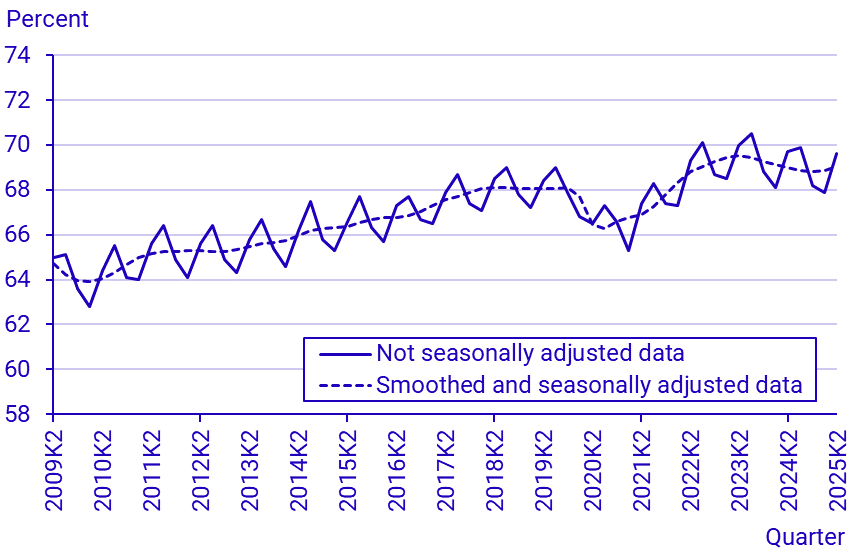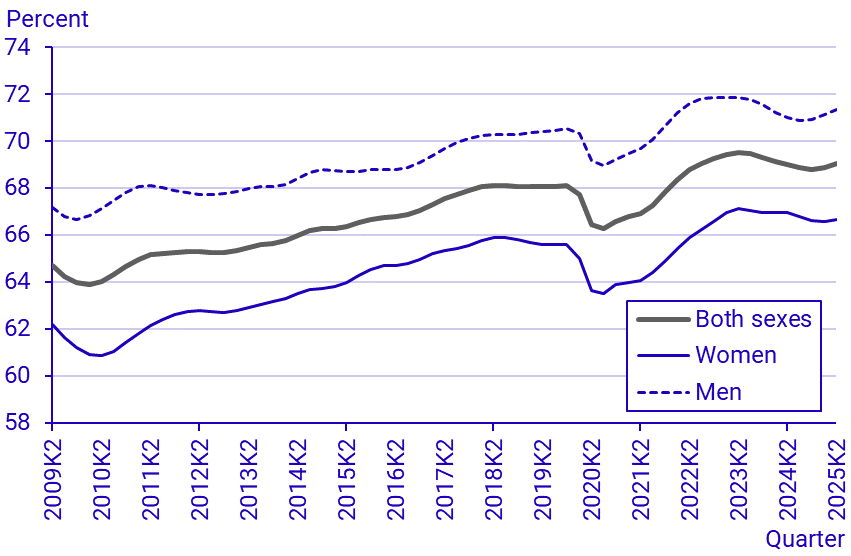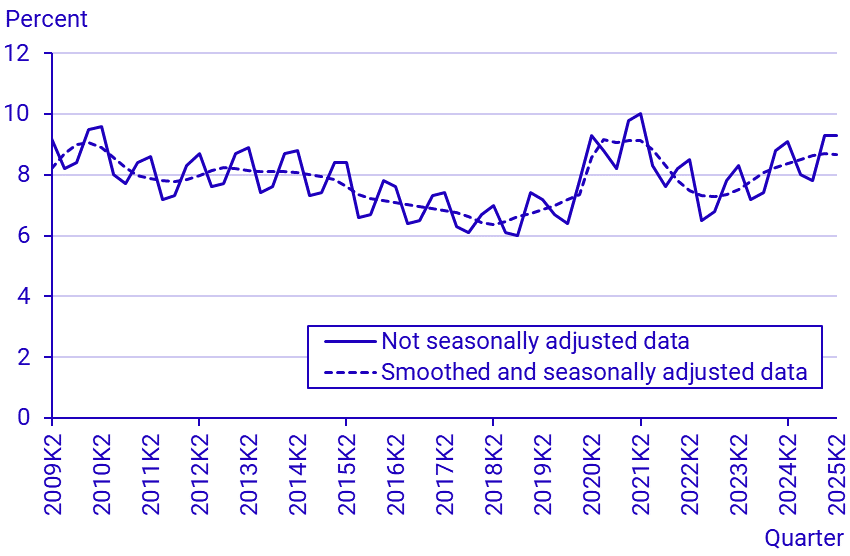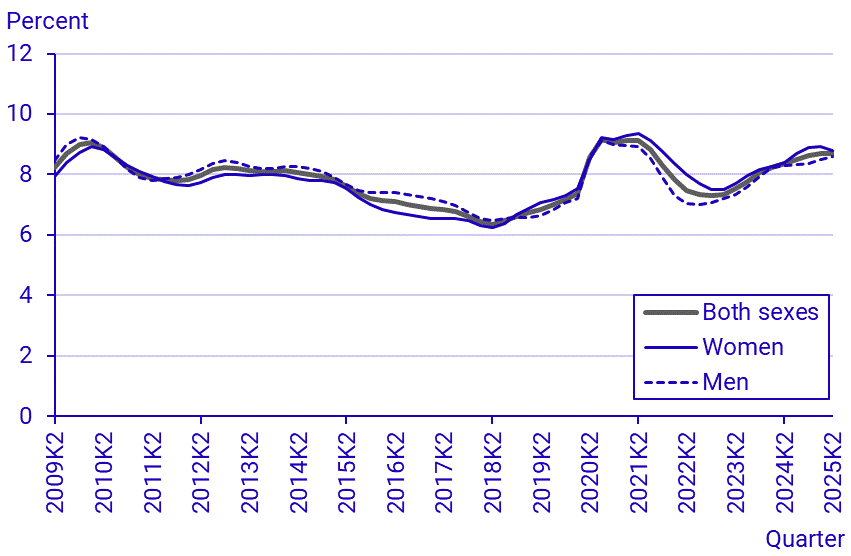Labour Force Survey (LFS), second quarter 2025
Unemployment remains on a higher level in the second quarter
Statistical news from Statistics Sweden 2025-08-19 8.00
In the second quarter of 2025, the number of employed people amounted to 5 306 000, not seasonally adjusted. The average number of hours worked per week decreased and amounted to 159.2 million hours. There were 545 000 unemployed people. This corresponds to an unemployment rate of 9.3 percent. Seasonally adjusted and smoothed data shows an increase in employment. The unemployment rate amounted to 8.7 percent.
– The labour market remained subdued during the second quarter of 2025 as unemployment persisted on a higher level. There were however some positive signs, for example we see an increase in seasonally adjusted and smoothed employment, says Charlotta Olofsson, statistician at the Labour Force Surveys at Statistics Sweden.
The labour force
The number of people in the labour force aged 15-74 years amounted to 5 851 000 in the second quarter of 2025, not seasonally adjusted. The number of women in the labour force amounted to 2 783 000 and the number of men was 3 068 000. The relative labour force participation rate amounted to 76.8 percent. Among women, the labour force participation rate was 74.1 percent and among men it was 79.3 percent.
According to seasonally adjusted and smoothed data in the second quarter of 2025, both the number and the share of people in the labour force increased compared to adjacent quarters. The number amounted to 5 767 000, which corresponds to a share of 75.6 percent.
Employment
In the second quarter of 2025, the number of employed persons amounted to 5 306 000 people aged 15–74 years, not seasonally adjusted. This corresponds to an employment rate of 69.6 percent. Among women, the number of employed was 2 528 000 and among men the number of employed amounted to 2 778 000. The employment rate for women was 67.4 percent and among men it was 71.8 percent. There were 554 000 young people aged 15–24 years in employment. This corresponds to an employment rate of 45.6 percent.
For people aged 15–74 years, seasonally adjusted and smoothed data shows an increase both in the share and number of employed people compared to adjacent quarters. The number of employed people in the second quarter of 2025 amounted to 5 266 000, which corresponds to an employment rate of 69.0 percent.
Employees
In the second quarter of 2025, there were 4 822 000 employees, not seasonally adjusted. The number of employees among women was 2 383 000 and the number of employees among men amounted to 2 439 000. The number of permanent employees amounted to 4 161 000. Among permanent employees, the number of men increased by 51 000 and amounted to 2 142 000, while the number of women was 2 019 000. There were 661 000 temporary employees. Among them 364 000 were women and 298 000 were men.
Seasonally adjusted and smoothed data shows an increase in the number of employees compared to adjacent quarters. The number of employees amounted to 4 781 000. Among these, 4 149 000 had a permanent employment and 632 000 a temporary employment. Seasonally adjusted and smoothed data shows an increase in the number of permanent employed.
Hours worked
The average number of hours worked per week in the second quarter of 2025 amounted to 159.2 million hours, not seasonally adjusted. In calendar adjusted figures, this corresponds to a decrease of 1.3 percent compared to the second quarter of 2024. According to seasonally adjusted and smoothed data, the number of hours worked averaged to 155.0 million per week. This is a decrease compared to adjacent quarters.
Most employed people have an agreed working time of 35 hours or more per week, that is, full-time work. In the second quarter of 2025, 4 155 000 people worked full time. Among them 1 851 000 were women and the number of men was 2 304 000. In total, 291 000 people worked short part-time (1–19 hours), and the number of people who worked long part time (20-34 hours) amounted to 606 000 people.
The average actual hours worked among employed people aged 15–74 years amounted to 30.1 hours per week in the second quarter of 2025, a decrease of 0.5 hours. The average actual hours worked among men decreased with 0.6 hours and amounted to 32.1 hours per week. Women worked 27.8 hours per week.
Underemployment
Among employed people aged 15–74 years, 407 000 were underemployed in the second quarter of 2025, which is an increase of 48 000 compared to the same quarter previous year. The number of underemployed men increased by 33 000 and amounted to 218 000. The number of underemployed women was 190 000. Underemployed people accounted for 7.7 percent of employed people.
Unemployment
In the second quarter of 2025 the number of unemployed people aged 15–74 years amounted to 545 000, not seasonally adjusted. The unemployment rate amounted to 9.3 percent. There were 255 000 unemployed women. The number of unemployed men was 290 000. The unemployment rate for women was 9.2 percent and the corresponding number for men was 9.5 percent.
According to seasonally adjusted and smoothed data, the number of unemployed amounted to 500 000, which corresponds to an unemployment rate of 8.7 percent.
There were 163 000 long-term unemployed people (unemployed for at least 27 weeks) aged 15–74 years in the second quarter of 2025, not seasonally adjusted. Among long-term unemployed people, the number of women was 76 000 and the number of men amounted to 87 000.
The number of unemployed young people aged 15–24 years amounted to 212 000 of which 147 000 were full-time students, not seasonally adjusted. This corresponds to an unemployment rate of 27.7 percent. The number of unemployed young people aged 15–24 years amounted to 164 000 according to seasonally adjusted and smoothed data, corresponding to an unemployment rate of 23.7 percent.
Not in the labour force
The group 'not in the labour force' includes people who are not classified as employed nor as unemployed. In the second quarter of 2025, there were 1 771 000 people not in the labour force. The number of women not in the labour force was 970 000 and the number of men was 801 000.
Among people not in the labour force, 817 000 were retired, 472 000 were full-time students and 280 000 people reported that they were on long-term sick leave.
Latent job seekers
People who can and would like to work, but who are not looking for work, are called latent job seekers. There were 238 000 latent job seekers aged 15–74 years in the second quarter of 2025. Among them 113 000 were women and 125 000 were men. Among young people aged 15–24 years, the number of latent job seekers was 108 000.
Unused labour supply
Unemployed people, underemployed people and latent job seekers together comprise the unused labour supply. In the second quarter of 2025, the unused labour supply averaged 26.5 million hours per week. The unused labour supply corresponds to 663 000 full-time employments with 40-hour work weeks.
Labour market for people aged 20-65 years
The population presented by the LFS is comprised of people aged 15–74 years. However, labour market participation among younger and older in this age group is considerably lower for natural reasons, as this group contains large shares of students and retired people. To better approach what can be seen as the core of the actively working population, the situation of the age group 20–65 years is described in the following section.
The relative labour force participation rate among people aged 20–65 years amounted to 88.4 percent in the second quarter of 2025, not seasonally adjusted. For women, the relative workforce participation rate was 86.0 percent, and for men 90.8 percent. Seasonally adjusted and smoothed data shows a participation rate of 87.9 percent, which is an increase compared to adjacent quarters.
In the second quarter of 2025, the share of employed people aged 20–65 years was 81,7 percent, not seasonally adjusted. For women, the share of employed people was 79.5 percent and for men it was 83.8 percent. According to seasonally adjusted and smoothed data, the employment rate amounted to 81.3 percent, which is an increase compared to adjacent quarters.
According to not seasonally adjusted data, the unemployment rate in the age group 20–65 years amounted to 7.6 percent. The unemployment rate among women was 7.5 percent and among men it was 7.7 percent. The seasonally adjusted and smoothed unemployment rate was 7.5 percent.
Swedish born and foreign born people aged 20–65 years
The relative labour force participation rate among Swedish born people aged 20–65 years was 88.8 percent in the second quarter of 2025, not seasonally adjusted. Among Swedish born women the labour force participation rate was 87.1 percent, and among Swedish born men it was 90.4 percent. Among foreign born people aged 20–65 years, the relative labour force participation rate was 87.5 percent. The corresponding figure among foreign born women was 83.0 percent and 92.0 percent among foreign born men. According to seasonally adjusted and smoothed data, the labour force participation rate was 88.2 percent among Swedish born people and 86.9 percent among foreign born people. This was an increase among both foreign and Swedish born people compared to adjacent quarters.
In the second quarter of 2025, the share of employed Swedish born people aged 20–65 years amounted to 84.4 percent, not seasonally adjusted. Among Swedish born women, the employment rate was 83.3 percent, and among Swedish born men the employment rate was 85.4 percent. The employment rate was 74.7 percent among foreign born people. Among foreign born men the rate increased by 2.7 percentage points to 79.5 percent. The corresponding rate among foreign born women 69.8 percent. Seasonally adjusted and smoothed data shows that the employment rate was 84.1 percent among Swedish born people and 73.9 percent among foreign born people. This was an increase among foreign born people compared to adjacent quarters.
The relative unemployment rate among Swedish born people aged 20–65 years was 5.0 percent in the second quarter of 2025, not seasonally adjusted. This is an increase by 0.8 percentage points compared to the corresponding quarter of 2024. Among Swedish born men, the unemployment rate increased by 1.2 percentage points to 5.5 percent. Among Swedish born women the rate was 4.4 percent. The unemployment rate among foreign born people was 14.7 percent. Among foreign born women it was 15.9 percent and among foreign born men the corresponding rate was 13.6 percent. Seasonally adjusted and smoothed data shows that the unemployment rate was 4.7 percent among Swedish born people and 15.0 percent among foreign born people. This was an increase among Swedish born people and a decrease among foreign born people compared to adjacent quarters.




Source: Statistics Sweden
Definitions and explanations
Since the LFS is a sample survey, the results are subject to some uncertainty. The LFS basic tables contain uncertainty figures and refer to non-seasonally adjusted data.
Seasonally adjusted and smoothed data (trend values): data in which normal seasonal variations have been removed, then smoothed to reduce sampling error and short-term variations. Seasonally adjusted and smoothed data may be revised following new monthly outcomes and usually does not coincide with non-seasonally adjusted data. Seasonally adjusted and smoothed data is not to be compared with non-seasonally adjusted data.
More detailed results are available in the form of figures and tables on employed persons, hours worked, unemployed persons and more, on Statistics Sweden’s website.
Next publishing will be
2025-08-22.
Feel free to use the facts from this statistical news but remember to state Source: Statistics Sweden.
